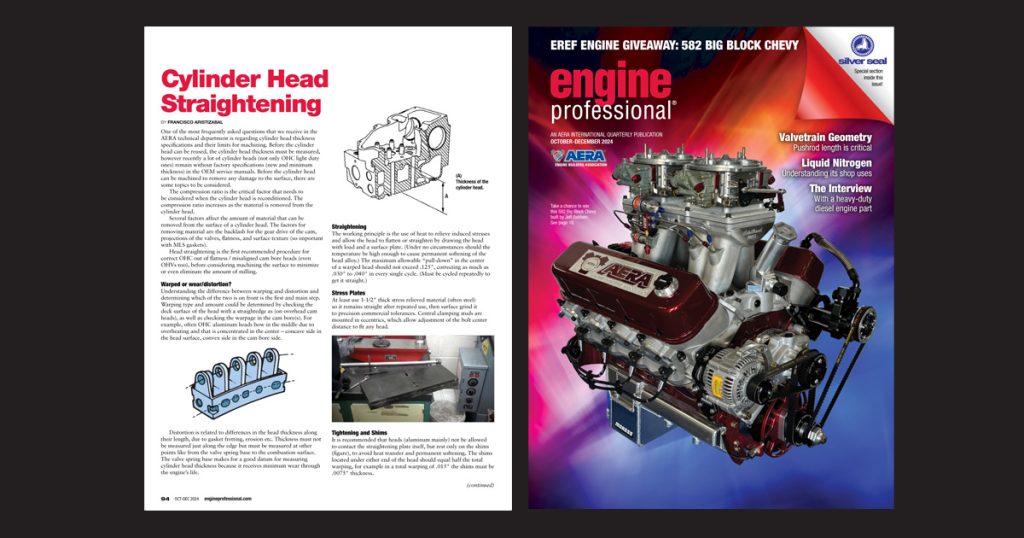By Francisco Aristizabal
One of the most frequently asked questions that we receive in the AERA technical department is regarding cylinder head thickness specifications and their limits for machining. Before the cylinder head can be reused, the cylinder head thickness must be measured, however recently a lot of cylinder heads (not only OHC light duty ones) remain without factory specifications (new and minimum thickness) in the OEM service manuals. Before the cylinder head can be machined to remove any damage to the surface, there are some topics to be considered.
The compression ratio is the critical factor that needs to be considered when the cylinder head is reconditioned. The compression ratio increases as the material is removed from the cylinder head.
Several factors affect the amount of material that can be removed from the surface of a cylinder head. The factors for removing material are the backlash for the gear drive of the cam, projections of the valves, flatness, and surface texture (so important with MLS gaskets).
Read this article with all images in the digital issue of Engine Professional magazine https://engineprofessional.com/2024EPQ4/#p=96
Head straightening is the first recommended procedure for correct OHC out of flatness / misaligned cam bore heads (even OHVs too), before considering machining the surface to minimize or even eliminate the amount of milling.
Warped or Wear/Distortion?
Understanding the difference between warping and distortion and determining which of the two is on front is the first and main step. Warping type and amount could be determined by checking the deck surface of the head with a straightedge as (on overhead cam heads), as well as checking the warpage in the cam bore(s). For example, often OHC aluminum heads bow in the middle due to overheating and that is concentrated in the center – concave side in the head surface, convex side in the cam bore side.
Distortion is related to differences in the head thickness along their length, due to gasket fretting, erosion etc. Thickness must not be measured just along the edge but must be measured at other points like from the valve spring base to the combustion surface. The valve spring base makes for a good datum for measuring cylinder head thickness because it receives minimum wear through the engine’s life.
Straightening
The working principle is the use of heat to relieve induced stresses and allow the head to flatten or straighten by drawing the head with load and a surface plate. (Under no circumstances should the temperature be high enough to cause permanent softening of the head alloy.) The maximum allowable “pull-down” in the center of a warped head should not exceed .125″, correcting as much as .030″ to .040″ in every single cycle. (Must be cycled repeatedly to get it straight.)
Stress Plates
At least use 1-1/2″ thick stress relieved material (often steel) so it remains straight after repeated use, then surface grind it to precision commercial tolerances. Central clamping studs are mounted in eccentrics, which allow adjustment of the bolt center distance to fit any head.
Tightening and Shims
It is recommended that heads (aluminum mainly) not be allowed to contact the straightening plate itself, but rest only on the shims (figure), to avoid heat transfer and permanent softening. The shims located under either end of the head should equal half the total warping, for example in a total warping of .015″ the shims must be .0075″ thickness.
Tightening the head deck-side down to the plate so that the center is touching the plate.
Heat Source
Always heat heads in an oven (preferably rather than using a torch for the purpose of temperature management) at approximately 500°F (260°C) for a minimum of four hours for a cast iron head. Aluminum heads should be heated in the 400°F (204°C) range, for between 2 and 4 hours, based on the thickness of the head, with very slow cooling after the oven cycle is complete to help reduce the risk of cracking. It is recommended that aluminum cylinder heads are not heated never beyond 482°F (250°C) when straightening.
After each cycle, the head must be checked for flatness and cam bore misalignment to verify the progress and repeat the cycle if necessary. As always, we mention all this info as it is intended to serve as a general guide. Specific procedures may vary depending on the equipment manufacturer/application. Always check their literature and any other OEM service recommendations, the AERA tech line is also available to solve questions in these matters.
Read this article with all images in the digital issue of Engine Professional magazine https://engineprofessional.com/2024EPQ4/#p=96

